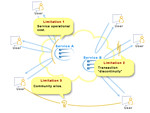 Recently, users have been bombarded with new types of Web applications often referred to as "AJAX Applications." From an end-user point of view, these Web applications add a new level of interactivity, which was previously the domain of desktop applications.
Recently, users have been bombarded with new types of Web applications often referred to as "AJAX Applications." From an end-user point of view, these Web applications add a new level of interactivity, which was previously the domain of desktop applications.
Some good examples of AJAX applications are GMap, Google Suggest, Interactive Domain Search, and Windows Live.
On the technical side, AJAX is a term describing an approach at developing more interactive Web applications. Although AJAX might look like new technology, AJAX technologies have been around for a while. So, what made AJAX such a sudden phenomenon? And, why now?
The natural first explanations are technical.
- One could say that browsers were not powerful and flexible enough to support these types of applications. However, most of the AJAX applications run on Microsoft IE (MS-IE) 5, which was released in 1999. Mozilla 1.2, the first robust modern browser, was released in 2002.
- Another argument is that the PC has become more powerful and therefore, has enabled users to take advantage of these new processor-demanding applications. However, AJAX applications do not consume that much processing, and the end-consumer PC market has not evolved as fast as the popularity of these new applications.
While these technical reasons are valid to some extent, the main factors for this recent trend might be more of a social nature and the result of a good timing of confluent events. I see the following three main “events” as catalysts for this new trend:
- A name (AJAX): Jesse James Garrett did a great job at naming and describing an approach to building new Web applications. This has allowed the industry to have a common understanding and terminology about these technologies.
- The perception of feasibility (Firefox): MS-IE 5.0 was too Windows-centric to be the only bet for mainstream Web spplications and Mozilla 1.2, while sufficient, was not recognized as a valid alternative. Consequently, the majority of the Web stayed with the lowest common denominator. Fortunately, the fulgurant Mozilla Firefox popularity growth reestablished developer confidence in MS-IE alternatives and "re-balanced the Web" toward standards and true cross platforms.
- Proof of concept (GMap): One of the most future-looking internet companies, Google, released a dazzling mapping "AJAX" application to the public (GMap). This was the best validation of the AJAX approach… probably to date.
It was fascinating to witness these three events happening almost in perfect harmony. I guess it was such a needed evolution that everybody naturally did their part of the puzzle.
In any case, this new approach is a much needed update for many current Web applications. It will interesting to see if the innovation will come from the incumbent or newcomers. So far, with the exception of Google, most of the real innovation in this space has come from startups. However, with Yahoo and Microsoft in the race, this might change.
Honestly, AJAX does not solve all Web application limitations. For example, Offline, Desktop Integration will still require some sort of plug-ins…which are very browser dependent…there is no free lunch…except at Google, I guess.



 In the early days of the Internet, innovators and venture firms were equally important forces behind the internet evolution. At the time, most Internet ideas needed some external funding to get started. Consequently, ideas often started with the now infamous PowerPoint presentation to the VC. If ideas were accepted, most first round funds were devoted to building the proof of concept and generating enough buzz to acquire a user base. As a result, venture firms played key role in choosing which idea or group of people would start or not.
In the early days of the Internet, innovators and venture firms were equally important forces behind the internet evolution. At the time, most Internet ideas needed some external funding to get started. Consequently, ideas often started with the now infamous PowerPoint presentation to the VC. If ideas were accepted, most first round funds were devoted to building the proof of concept and generating enough buzz to acquire a user base. As a result, venture firms played key role in choosing which idea or group of people would start or not. Recently, users have been bombarded with new types of Web applications often referred to as "AJAX Applications." From an end-user point of view, these Web applications add a new level of interactivity, which was previously the domain of desktop applications.
Recently, users have been bombarded with new types of Web applications often referred to as "AJAX Applications." From an end-user point of view, these Web applications add a new level of interactivity, which was previously the domain of desktop applications.  In the last couple of weeks Microsoft has been pretty loud around the "new Internet wave." First, with the announcement of
In the last couple of weeks Microsoft has been pretty loud around the "new Internet wave." First, with the announcement of 